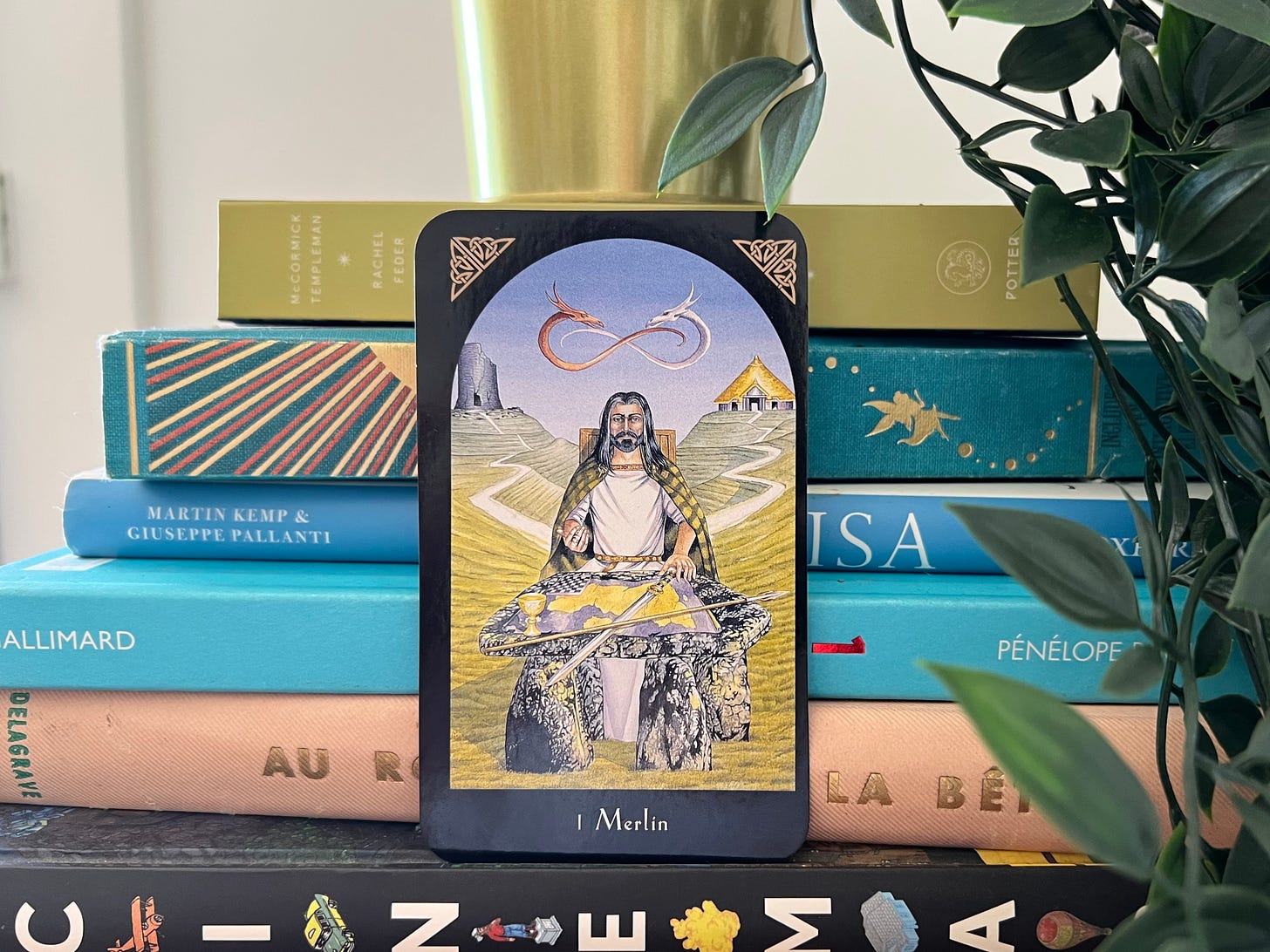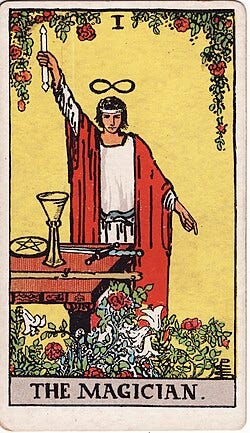This summer, I’m guiding you through a tarot takeover of Julia Cameron’s 12 week creative recovery program, The Artist’s Way. Each Monday, I’ll pair a key theme from the book with a tarot archetype, and share fresh insights on The Artist’s Way’s message, through a tarot-lens. Today, we’re diving into Week 3: Recovering a Sense of Power with The Magician.
These brief Monday essays are free to read. To deepen your journey through access to live & recorded Sunday journaling sessions, original Morning Pages prompts, themed Artist Date suggestions, our community chat thread and more, consider becoming a paying subscriber to The Shuffle.
Week Three of our tarot-informed journey through The Artist’s Way empowers us to manifest our raw creativity…
The Magician can teach us how to channel and use the creative power we’ve been recovering and discovering within and around us…
ICYMI, the replay recording of our latest Tarot Artist’s Way journaling session is here.
The Artist’s Way shares DNA with many archetypal narratives: the Tarot’s Major Arcana sequence, Joseph Campbell’s Hero’s Journey, Arthurian legend. In each of these, a seeker (“blocked artist”, “Fool”, or “hero”) must embrace discomfort and leave behind all they know in search of something deeper, something healing, something life-(or even world)-changing.
While the early stages of each narrative focus on the seeker’s internal struggle to accept a call to action, things only really get going once the seeker meets with what Campbell calls a “supernatural aid … a figure [which] represents [the] benign, protecting power of destiny.1”
Classic Campbellian plots like Star Wars, Harry Potter, and The Hobbit externalise this figure as a wise guide: Yoda, Dumbledore, Gandalf. These archetypes draw on the older myth of Merlin, the wizard who manifested King Arthur’s birth and coronation, and served as a key advisor throughout his rule.
In the Fool’s journey of the tarot, the Magician card fills the archetypal role of supernatural aid… a wellspring of magic within themself, and a channel for magic that surrounds them.
Reading along with The Artist’s Way, we might consider Julia Cameron herself our wise guide, but we can also dig deeper to embrace our own inner artist as the benign, protecting power we need to move forward on our creative recovery journey.2
Hallowquest: Tarot Magic & the Arthurian Mysteries by Caitlin and John Matthews brings together classic monomythic archetypes with the tarot, casting the sorcerer Merlin as The Magician and citing among the card’s divinatory meanings: “The impulse of creation; imaginative insight … initiative; self-confidence … alignment to and free flow with one’s life patterns.”
It’s this free flow and impulse to create that Cameron zeros in on in Week Three of The Artist’s Way, suggesting that when we channel our anger, shame, fear… and also our curiosity into the the tools of the program (Morning Pages, Artist’s Dates, and Exercises), we don’t just discover more productive outlets for our rawest feelings, we open doors to synchronicity and opportunity. We manifest magic.
Creative power, she argues, is both inherent within us and also available all around us, if only we’re willing to be a channel: to let everything within flow out, and everything without flow in.
“To me, all creativity is magic. Ideas start out in the empty void of your head - and they end up as a material thing, like a book you can hold in your hand. That is the magical process. It's an alchemical thing. Yes, we do get the gold out of it but that's not the most important thing. It's the work itself.”
— Alan Moore
“Creation” and “creativity” are key words associated with the Magician across most guidebooks — and beyond. Not only do tarot scholars like the Matthews, Benebel Wen and Mary Greer note the card’s creative properties, but artists themselves seem to have a special relationship with the card’s identity as a creative channel: Salvador Dali and Italo Calvino both posed as the Magician.
It’s not surprising: art is magic, after all. Through it, ideas and dreams are transformed into reality. Like the Magician, whose “real magic” lies, in the Matthews’ words, in the “mediation of inner and outer worlds”, art is a mediation of inner and outer worlds too. Our ideas and dreams, when channelled through artistic media, can be held and experienced beyond us.
Most versions of the Magician feature the character in the midst of spell casting. Their altar is laid with the icons of the four tarot suits — which themselves represent the four magical elements: a cup (water), a sword (air), a wand (fire), and a pentacle (earth).
As creatives, we might reimagine these items, from esoteric objects to our preferred artistic tools: the wand becomes a paintbrush, the cup a drum, the sword a pen, the pentacle a roll of film.
It’s up to the Magician — to us — to wield these tools. To transform them, through intention and action, from ordinary objects into channels of creative power. To spin a dream into gold and cherish the product of our own power in our hands. And then, to do the most magical thing of all: keep dreaming, keep making, and keep trusting the process. •
Join me live on Sunday, June 1st at 7pm UK / 2pm Eastern / 11am Pacific for a tarot journaling event where we’ll reflect back over the past week and pull cards for guidance on continuing to weild our creative power.
Below, full-access subscribers to The Shuffle can find:
Morning Pages prompts
Artist’s Date suggestions
What’s next
A discount code for my limited edition Inner Artist tarot letter







